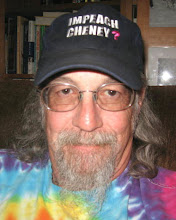It was truly inspiring to hear that Ashley Casale, 19, and Michael Israel, 18, decided to walk 3,000 miles across the country for peace. They began their journey on May 21 in San Francisco and plan to end up in Washington, D.C. on September 11. Such a commitment to the cause of peace is unusual and admirable!
The two teenagers have been discouraged, however, by the negative reception they have received by some people and by the lack of participation by those who support the peace movement.
Actually, their reaction seems to be universal for peace activists across the country who put much time and energy into standing for peace only to be ignored by the media and dismissed by the now-miniscule number of Bush-supporters. What is even more baffling is that they are thanked and congratulated by the 70 percent of those who want the United States to end the war in Iraq-but who do nothing about it.
Perhaps we need to look at our peace activism in a different way.
On January 1, 1953, a 44-year-old woman began a journey that would amount to her walking 25,000 miles over the next 28 years of her life.
Her first walk began in Pasadena, California, at the head of the Rose Bowl Parade so that she would be seen. She then set out to deliver two petitions to President Eisenhower: one to end the Korean War and one to establish a Department of Peace. The third petition she delivered to the United Nations: a request to disarm the world and redirect the funds for arms to funds for human need. She went by the name of Peace Pilgrim.
Peace Pilgrim was distressed over the world at that time so she prayed and contemplated what she could do about it. The nuclear age had begun, the Korean War was on, and Senator Joe McCarthy was out hunting communists.
The five-foot-two woman wore a blue tunic, the color of peace, with white letters that read “Peace Pilgrim.” She carried no money, made no plans, and sometimes slept in haystacks, drain pipes, or barns. Sometimes she didn’t eat.
Peace Pilgrim didn’t approach other people but instead waited until people approached her. They often invited her to their house. She would talk with them about her life story of transformation and commitment to peace. This would inevitably prompt questions for them such as:
· “Wouldn’t it be better to uplift each other rather than destroy each other?
· How am I going to live a meaningful life?
· What choices have I made in my life already?
· What do I need to change in my life to make a difference?”
Peace Pilgrim was invited to give presentations in churches, schools and in homes; she spoke on radio and television. She corresponded with thousands of followers and answered every letter (through her sister in New Jersey) and published a newsletter, Peace Pilgrim’s Progress.
In 1972 Peace Pilgrim came to Kalamazoo to speak at Western Michigan University. Amy Anderson attended the lecture as part of a philosophy class she was taking there.
“I was so inspired and overwhelmed by her,” said Amy, “that I asked the woman next to me, my classmate, if we shouldn’t invite Peace Pilgrim to lunch.” She agreed and the three women met at the Anderson home for a lunch of scrambled eggs and green grapes. Throughout the afternoon they talked about Peace Pilgrim’s adventures as a walker, how she got started walking and ways she spread peace from one person to another.
At the conclusion of their visit, Amy offered Peace Pilgrim a bunch of grapes to carry with her, but she refused saying that she didn’t carry food with her. Amy then offered Peace Pilgrim a ride to her next location, about 40 minutes away, partially by freeway. Peace Pilgrim usually avoided walking on freeways so she accepted Amy’s offer, but only as far as the exit.
“She got out of the car, thanked me and walked on her way. I never saw her again,” said Amy with a sigh. “But Peace Pilgrim affected my life a great deal. She was a blessing to me. I thought that if she could affect others like she affected me, then her life was a blessing to the United States and the world.”
Amy showed me her paperback book on Peace Pilgrim and handled it reverently. She pointed to the back cover that quoted Peace Pilgrim’s mantra: “I shall remain a wanderer until mankind has learned the way of peace, walking until given shelter and fasting until given food.”
“Actually, Peace Pilgrim’s philosophy was rather simple,” said Amy as she opened the book and read from the inside cover page: “This is the way of peace: overcome evil with good, and falsehood with truth, and hatred with love.”
Amy closed the book, heaved a sigh and shut her eyes momentarily. “That’s what affected my life: that woman and this statement. But I’m just an ordinary person who did what I could to make a difference.”
Ordinary indeed. As a wife and mother in the 1950s and 60s Amy did all the usual things: school, PTA, church, hospital. She assisted the youth minister at her church for 11 years and recently helped set up the walk-in health clinic there. But Peace Pilgrim took Amy to a new level where she could be “more brave” and less afraid of what other people thought about her activism. “Peace Pilgrim put a little starch in my spine,” said Amy.
Amy’s foray into the peace movement began with the Nuclear Freeze movement of the 1980s. She served as secretary of the local group for nine years and collected documents on everything this group ever did. She inadvertently became the Kalamazoo peace movement’s archivist. During the 1990s she worked the cameras for social justice programs at the local cable TV station. Today, at 77, Amy still attends peace activities and sometimes stands on the corner at the peace group’s Sunday vigil.
Maybe, like Amy, we need to be more ordinary. Maybe like Peace Pilgrim, we need to be more confident in our vision. Maybe, like Ashley and Michael, we need to be more willing to do something for peace in public.




























No comments:
Post a Comment